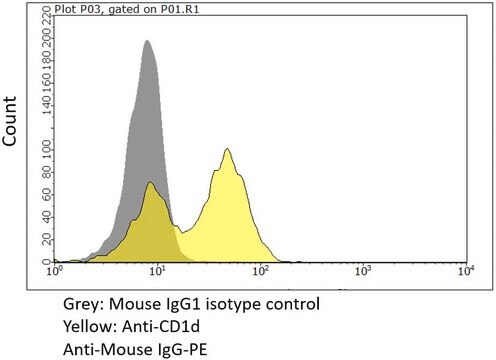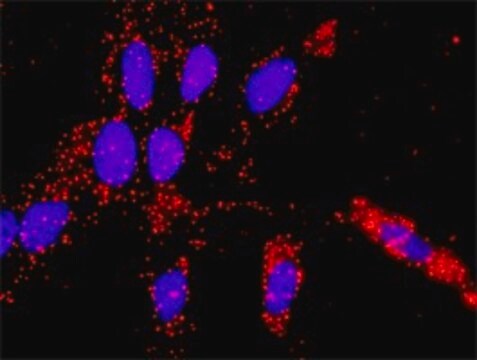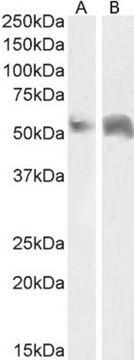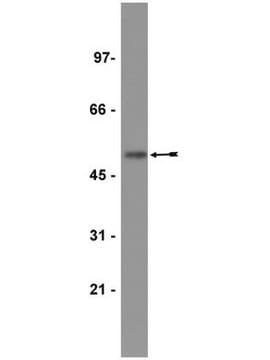MABC983
Anti-CD1d Antibody, clone D5
clone D5, from mouse
Sinonimo/i:
Antigen-presenting glycoprotein CD1d, R3G1, CD1d
Scegli un formato
Scegli un formato
About This Item
Prodotti consigliati
Origine biologica
mouse
Livello qualitativo
Forma dell’anticorpo
purified antibody
Tipo di anticorpo
primary antibodies
Clone
D5, monoclonal
Reattività contro le specie
human
tecniche
immunoprecipitation (IP): suitable
western blot: suitable
Isotipo
IgG2bκ
N° accesso NCBI
N° accesso UniProt
Condizioni di spedizione
wet ice
modifica post-traduzionali bersaglio
unmodified
Informazioni sul gene
human ... CD1D(912)
Descrizione generale
Immunogeno
Applicazioni
Apoptosis & Cancer
Apoptosis - Additional
Western Blotting Analysis: A representative lot detected exogenously expressed CD1d in CD1d-transfected C1R human lymphoblastoid cells (Kim, H.S., et al. (1999). J Biol Chem. 274(14):9289-9295).
Immunoprecipitation Analysis: A representative lot immunoprecipitated intact as well as degraded CD1d from human penile urethral epithelial (PURL) cells following C. trachomatis (Kawana, K., et al. (2007). J Biol Chem. 282(10):7368-7375).
Immunoprecipitation Analysis: A representative lot immunoprecipitated exogenously expressed CD1d independent of glycosylation states from lysates of CD1d-transfected FO-1 human melanoma cells (Kim, H.S., et al. (1999). J Biol Chem. 274(14):9289-9295).
Qualità
Western Blotting Analysis: 4.0 µg/mL of this antibody detected CD1d in 10 µg of THP-1 cell lysate.
Note: Longer exposure time is needed when using total lysates for Western blotting applications. Membrane preparation or immunoprecipitation can be employed to enrich membrane target proteins prior to Western blotting.
Descrizione del bersaglio
Stato fisico
Stoccaggio e stabilità
Altre note
Esclusione di responsabilità
Non trovi il prodotto giusto?
Prova il nostro Motore di ricerca dei prodotti.
Codice della classe di stoccaggio
12 - Non Combustible Liquids
Classe di pericolosità dell'acqua (WGK)
WGK 1
Punto d’infiammabilità (°F)
Not applicable
Punto d’infiammabilità (°C)
Not applicable
Certificati d'analisi (COA)
Cerca il Certificati d'analisi (COA) digitando il numero di lotto/batch corrispondente. I numeri di lotto o di batch sono stampati sull'etichetta dei prodotti dopo la parola ‘Lotto’ o ‘Batch’.
Possiedi già questo prodotto?
I documenti relativi ai prodotti acquistati recentemente sono disponibili nell’Archivio dei documenti.
Filtri attivi
Il team dei nostri ricercatori vanta grande esperienza in tutte le aree della ricerca quali Life Science, scienza dei materiali, sintesi chimica, cromatografia, discipline analitiche, ecc..
Contatta l'Assistenza Tecnica.








